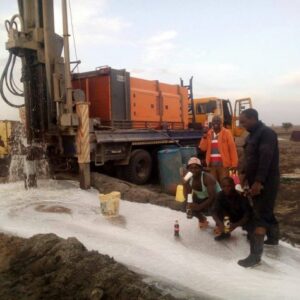 Once the hydro-geologists have helped us prep a path for borehole drilling, we follow through and construct the borehole. Water borehole drilling (or water well drilling), essentially, involves drilling a hole into the ground to access the water that lies beneath. Once the hole has been drilled, it is cased with steel and a borehole pumping system is typically added to collect the natural water and pump it to the surface. This is an effective way of providing a high-quality source of water direct from the ground below, allowing you to access clean water whenever you require it.
Once the hydro-geologists have helped us prep a path for borehole drilling, we follow through and construct the borehole. Water borehole drilling (or water well drilling), essentially, involves drilling a hole into the ground to access the water that lies beneath. Once the hole has been drilled, it is cased with steel and a borehole pumping system is typically added to collect the natural water and pump it to the surface. This is an effective way of providing a high-quality source of water direct from the ground below, allowing you to access clean water whenever you require it.
Key steps in borehole drilling
The process of water borehole drilling can be broken down into four steps.
Step 1 – a hydrogeologist will first need to visit the intended borehole site and assess its geophysical properties. They will identify where the water is located and how it can be reached. One of the experienced team from Shoeman Kenya Ltd will be on hand to perform this, giving you all the information you need in regards to how we can complete your project safely and effectively.
Step 2 – the water borehole will then be drilled in line with the hydrogeologist’s recommendations, and subsequently cased with steel, stainless steel, PVC or a combination of all of them. This keeps the borehole safe and secure, ensuring that it will continue to perform at the highest standards for the long term, despite challenging outdoor conditions.
Step 3 – a test pump will then be installed, and the borehole will be tested on a range of variables. This will determine the impact of certain controlled changes on the overall borehole water level.
Step 4 – finally, an appropriate pumping and piping system will be installed into the borehole.

